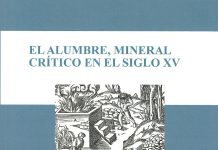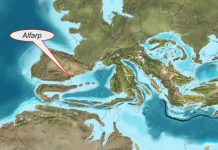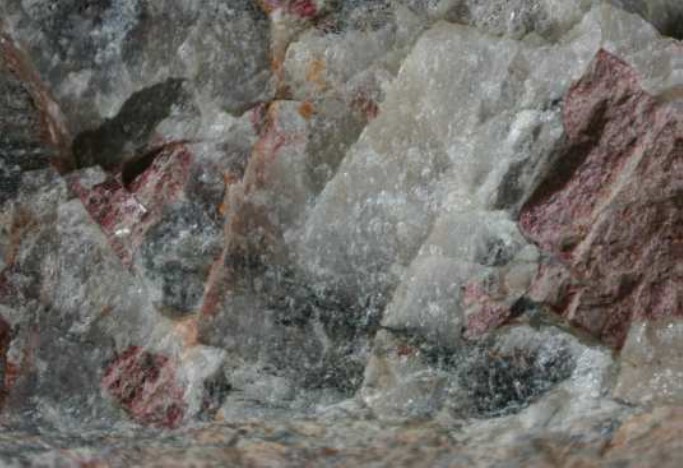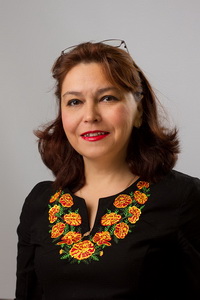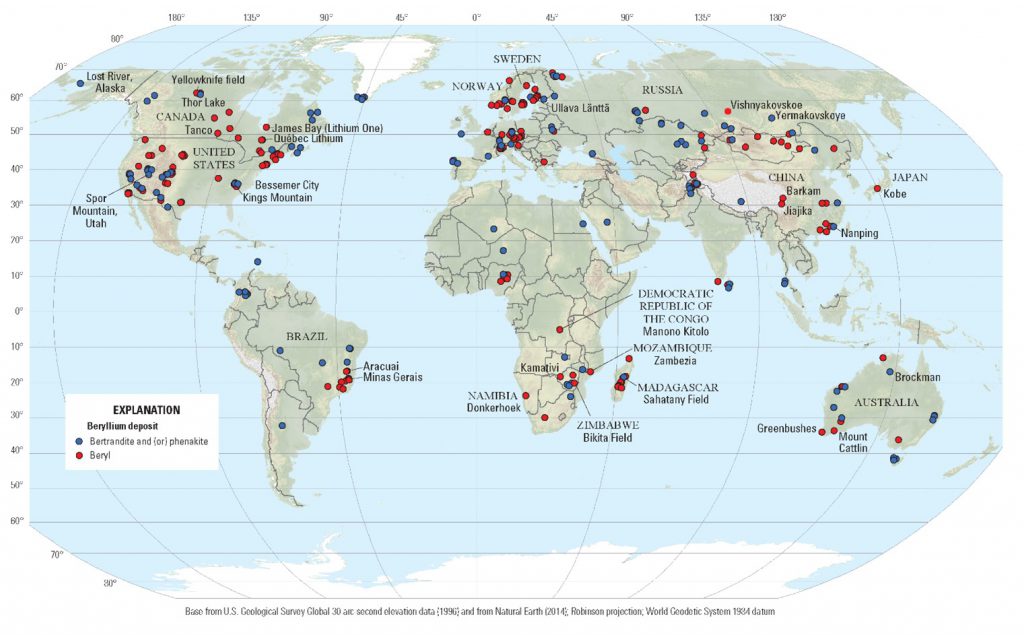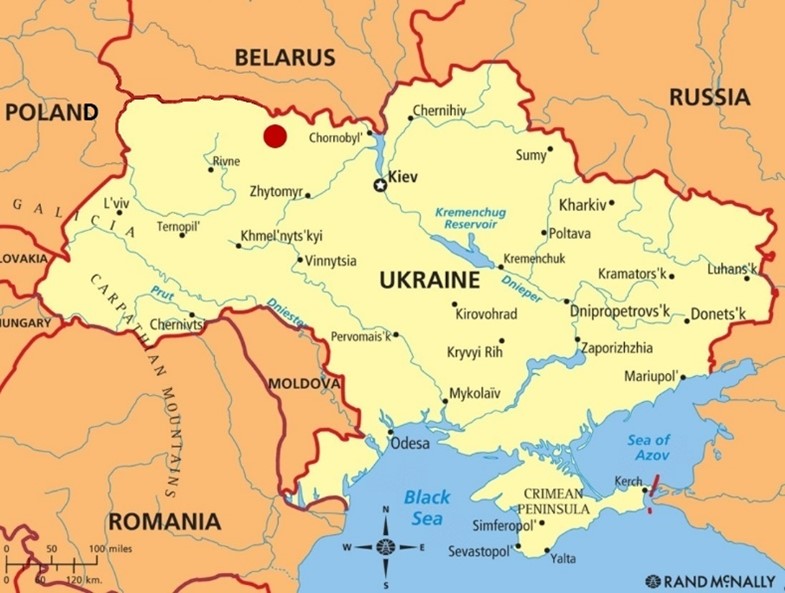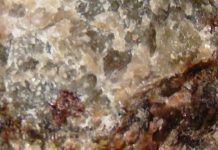TIERRA Y TECNOLOGÍA Nº 60 | DOI: https://dx.doi.org/10.21028/hl.2022.09.15 | Autora: Hanna Liventseva. Chairman of the Board of Ukrainian Association of Geologists.
INTRODUCTION
In Ukraine, beryllium mineralization was identified within the Ukrainian Shield (Ush) in Volynsky (Perga deposit, occurrances in the endo and exocontacts of the Korostensky pluton), Central (rare-metal deposits: Polokhivske, Stankuvatske, Nadiya; uranium deposits: Schorsivske, Central, Novokostyantynivske, Zhovtorichanske) and Priazovsky (deposits: Balka Kruta, Shevchenkivske, Elyseivske pegmatite field) districts.
The basis of the beryllium mineral resource base in Ukraine is the Perga deposit, prepared for exploitation and located in the northwestern part of the Ukrainian Shield.
The Perga deposit is associated with Perga granitoids and localized in a large «block» of foliation Perga granites between the Main and Southern faults of the north-eastern sublatitudinal strike, Ubortsky fault – of the north-eastern submeridional strike and Plotnytsky fault – of north-western strike.
| ABBREVIATIONS | |
| SCUMR | State Committee of Ukraine for Mineral Reserves |
| USh | Ukrainian Shield |
| SGSSU | State Geologic and Subsoil Survey of Ukraine, Ukrainian Geological Survey |
| NASU | National Academy of Sciences of Ukraine |
| IGMOF | M.P. Semenenko Institute of Geochemistry, Mineralogy and Ore Formation of NAS of Ukraine (IGMOF of NAS of Ukraine) |
GENERAL INFORMATION ABOUT BERYLLIUM
Beryllium is the metal of the space age and high technology. As one of the lightest metals with the corresponding physical, mechanical and thermal properties, beryllium is used in the electronic, aerospace and military industries.
Beryllium has an elasticity modulus 4 times greater than that of aluminum and 2.5 times greater than that of titanium.
It has the highest heat capacity among all metals, its tensile strength is maintained at temperatures up to 816 ° C, and geometric dimensions remain stable over a wide temperature range. It is the high shift strength and toughness, good conductivity and high resistance to fatigue cracking that contributed to the use of beryllium in many high-tech manufacturing areas and, above all, in communications.
This metal is used in nuclear reactors due to its ability to scatter atomic nuclei in combination with low density. Beryllium oxide is used as a substrate for high-density electronic circuits of high-speed computers, in lasers, radar electron-measuring systems.
Most of the beryllium reserves (85%) are spent on the production of alloys with Cu, Al, Mg, Ni, etc. Copper-beryllium alloys are used for manufacturing springs, connectors and switches, which are used in automobiles, aircraft and computers; the role of beryllium-aluminum alloys is growing. In recent years, the use of beryllium has changed significantly: TVs, computers, telecommunications came first, ahead of nuclear and space technology.
Beryllium-copper alloys are used in particularly critical parts of technical devices subjected to particularly intense stress (aircraft landing gear, quick-fire guns, contact brushes, cutting tools, bearings operating at high temperatures, etc.).
Alloys of beryllium with aluminum, magnesium, nickel, iron, chromium are used in machine engineering and tool making industries, and in the aviation industry.
Beryllides (intermetallics) are widely used in heat-resistant coatings, in particular, in rocket production. The above makes this type of mineral raw materials one of the most technologically advanced metals in a wide range of use.
GEOLOGICAL INDUSTRIAL TYPES OF BERYLLIUM DEPOSITS IN THE WORLD
The main geological industrial types of beryllium deposits (Fig.1):
- beryllium-bearing granite pegmatites with an average BeO content of 0.05-0.09% (deposits: the Minas Gerais in Brazil, the Kalba in Kazakhstan, the Bernik Lake in Canada, and the Kruta Balka in the Priazovsky megablock of the USh;
- gelvin and chrysoberyl skarns, characterized by significant spread and BeO content (0.1-0.15%) – Black Hills deposit in the USA, Thornbeck Lake in Canada;
- phenacite-genthelvite alkaline metasomatites are represented by microclinization zones in ancient granites and gneisses (0.3-0.55% BeO) – Perga deposit in Ukraine;
- Greisen quartz-vein formations containing beryllium (0.1-0.15% BeO) deposits: Malyshivske in Russia, Redskin Stock in the USA;
- fluorite-mica metasomatites containing beryllium, represented by mineralized crushing zones in various sedimentary-metamorphic rocks (0.1-0.16 BeO) – Panjshir deposit in Afghanistan;
- fluorite metasomatites containing bertrandite-phenakite, in limestones on the contact of small domes or granosyenite granites – is the richest type of ore (0.2-1.5% BeO): the Benger Flats deposit in the USA, Priargunsky region in Russia; at the Spor Mountain epithermal deposit Utah (USA), beryllium reserves proven in bertrandite ores amount to 16 thousand tons (by metal content);
- modified rhyolites containing gel-bertrandite (0.7% BeO) – Thomas Ranger deposit in the USA.
The main beryllium minerals that make up the ores are beryl (10-12% BeO), phenakite (42-45%), bertrandite (40-42%), gel-bertrandite (32-35%), chrysoberyl (18-20%), helvine and genthelvite (10-12% BeO).
The proven reserves of beryllium in various types of ores are distributed as follows according to industrial types: rare-metal pegmatites – 48% (China, Brazil, 0.03-0.3% BeO); bertrandite-argillizated metasomatites – 2 1% (USA, 0.6-1, 5% BeO); greisen (beryl-mica metasomatites and quartz-vein zones and stockworks) – 25% (Brazil, 0.3-0.3% BeO); beryllium feldspar metasomatites – 6% (Canada, 0.3-1.4 % BeO).
Among the beryllium deposits, the following predominate: greisens and quartz-vein formations containing beryllium (0.1-0.15% BeO); beryllium granite pegmatites (0.05-0.09%); helvine and chrysoberyl skarns (0.1-0.15%); phenakite-genthelvite alkaline metasomatites (0.3-0.55%); fluorite-mica metasomatites containing beryllium (0.1-0.16%); fluorite metasomatites containing bertrandite-phenakite (0.2-1.5%); rhyolites containing gel-bertrandite (0.7%).
Deposits are divided by BeO reserves (thousand tons) into: small is up to 1, medium is 1-5, large – 5-20, very large – 20-50 and unique – more than 50. For beryllium deposits, the minimum commercial content of Be in ores is 0.25-0.35% and 0.05-0.10% for complex ones.
BERYLLIUM MINERALIZATION IN UKRAINE
The Yastrebetsky stock of zirconium-rare-earth syenites, the Verbinsky bismuth-molybdenum ore occurrence, a number of promising ore occurrences of tin, wolframite, tantalum and niobium, as well as fluorite, are located within the Perga tectonic knot. 95% fluorite concentrate containing 0.16% Y2O3 can be obtained from high-tech fluorite ores of the latter. The complex development of these ore objects will create a rich mineral and raw material base of rare metals in the North-Western region of Ukraine.
Beryllium mineralization is often found in endo- and exocontacts of Korostensky pluton. Beryl, bertrandite and phenakite are common minerals in chamber pegmatites of the Volodarsk-Volynsky deposit. The content of BeO reaches 0.07% in the Leznykivska area, in thin (0.2-1.0 m) bodies, albitites and albite-zinwaldite greisens with phenakite among the albitized granites of Leznikovsky type. Beryl is also found in Korostyshivsk pegmatites within the southeast border of the Korostensky pluton.
In rare-metal pegmatites of the western border of the Korsun-Novomyrgorod pluton, beryllium mineralization is represented by chrysoberyl. The BeO content in the pegmatites of the Petroostrovsky-Polokhivsky ore occurrence varies in the range: 0.003-0.026% (Mostove ore occurrence), reaching 0.064% in the ore occurrence of Kopanka. In lithium ores of the Polokhivsky deposit, the content of beryllium is 0.032%, and 0.005% of the Nadiya deposit, 0.036% of the Stankuvate deposit.
The Korosten pluton borders, in general, including uranium-bearing albitites, is characterized by geochemical anomalies of beryllium due to the presence of phenakite. In a number of uranium deposits and ore occurrences, a higher beryllium content was found than in rare-metal pegmatites: in the Schorsivske deposit – Be content is up to 0.06%, in Central -it is up to 0.02% for a thickness of 10 m, in Novokostyantinovske – 0.015-0.05% for 2-5 m. Similar anomalies are known in Lisove, Dokuchaivske, Litnye and other deposits.
On the southern flank of the West Ingulets zone bordered by the Malyivsky granosyenite dome, the increased beryllium content (from 0.011 to 0.056%) is due to the presence of beryl, phenakite and helvine in the vesuvianite skarns. Helvine is also found in rare-metal pegmatites of the Zhovtorichansky ore occurrence of Krivbass.
In the Priazovsky region, in the rare-metal pegmatites of the Balka Kruta deposit, the beryllium content ranges from 0.001 to 0.017%, and beryl crystals (emeralds) are found. Chrysoberyl is characteristic of lithium ores of the Shevchenkivsky lithium deposit and is present in microcline-albite, spodumene-albite pegmatites, as well as in metasomatites that develop along them or contain pegmatites. The beryllium content here reaches 0.15%.
Beryl in the pegmatites of the Eliseevsky pegmatite occurrence (Western Azov region) is a quite common mineral (during the occupation of Ukraine by the Germans in the Second World War, its artisanal mining was carried out here).
Beryl in association with tantalum-niobate and cassiterite, found in mica-albite-microcline metasomatites and quartz-fluorite veins, are located in the mineralized apical parts of small granite massifs of the East Azov Sea – Katerinovsky, Kamyanomogilsky.
PERGA BERYLLIUM DEPOSIT
This deposit is located 2 km southeast of the village of Perga, Olevsky district, Zhytomyr región (Fig. 2)
The deposit is related to the Perzhansky granitoid.
The area of the deposit is 21 km2.
The Perga deposit was opened in 1960 by the Kyivgeology company.
In 1962-1977 detailed geological exploration works were carried out.
Reserves of beryllium ores and beryllium oxides were approved by the SCUMR of the USSR in 1977 (protocol No. 7936 of 10/25/1977).
Simultaneously with the study of beryllium ores, zinc ores and granites were studied.
Perzhanska Rudna Kompaniya LLC is a part of the group of the Ukrainian investment company BGV Group Management.
The activities of Perzhanska Rudna Kompaniya LLC are aimed at the development of the Perzhansk deposit and extraction of beryllium ores using environmentally safe and modern methods of mineral extraction.
On the basis of an electronic tender, Perzhanska Rudna Kompaniya LLC purchased a special permit (license) for the extraction of beryllium ores from the Perga deposit for a period of 20 years. A special permit gives the right to mine beryllium ores, zinc ores and granite [3].
Geological structure of Sushchano-Perga zone
The ore field of the Perga beryllium deposit is located in the central part of the Suschano-Perga tectonic zone and is formed mainly by granites of the Ukrainian shield Perga complex (Fig.3).
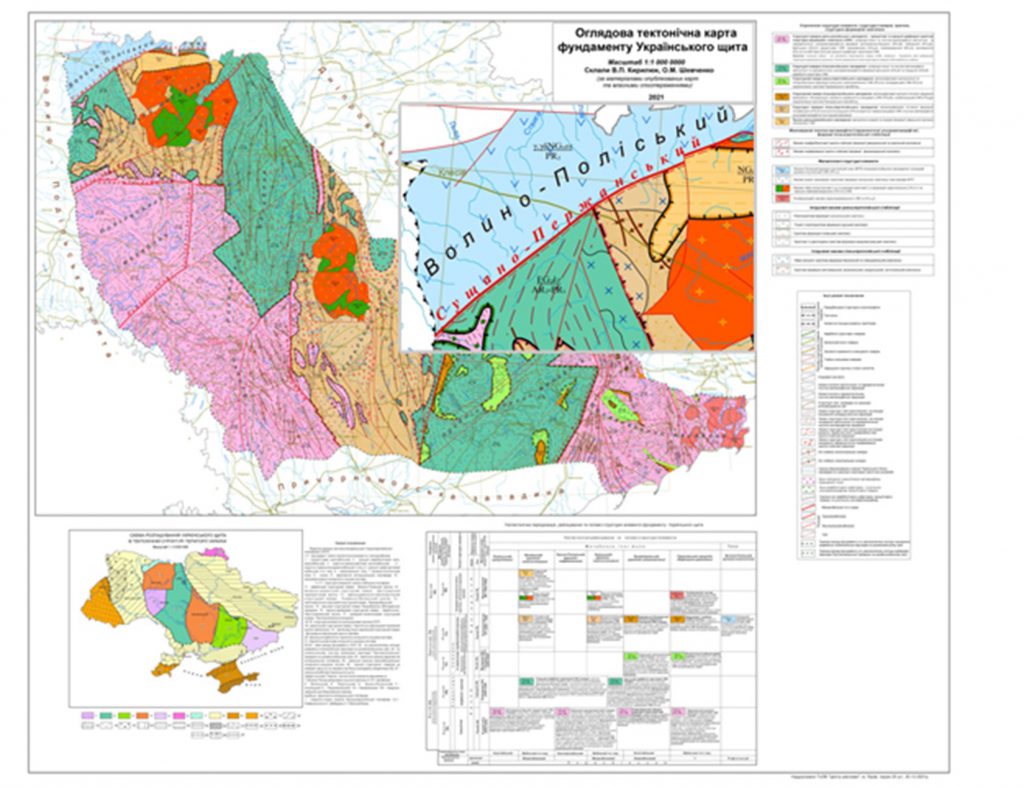
AlkAlkaline and subalkaline granites of the Perga complex (isochronous age according to cyrtolite is 1760-1730 million years] form the main petro-background of rock formations in the structure of the Sushchano-Perga zone and the Perga deposit.
Numerous occurrences of ore alkaline metasomatites are associated with them. The «Perga» type of granites was identified in 1929 by the outstanding geobgist M. I. Bezborodko. And the Perga granites as a separate complex were recognized by L.S. Galetsky. Who was the discoverer of the Perga beryllium deposit.
The Perga beryllium deposit – is the only one in the world where industrial concentrations of beryllium are associated with Gentgelvin. In addition to beryllium, the Perga deposit contains tantalum, niobium, zirconium, rare earth elements, tin, molybdenum, lithium, zinc, silver and fluorine. Fluoride-rare-earth-zirconium ores, disten, kyanite, columbite-zirconium-cassiterite placers were also discovered.
The northwestern region of the USh is a large rare-metal province, in some areas of which, deposits and commercially promising ore occurrences of beryllium, tantalum and lithium, zirconium, tin, titanium, plumbum and zinc, noble metals, high-alumina raw materials, fluorite ores are known.
First of all, it is necessary to emphasize the Perga ore deposit, located in the central part of the Sushchano-Perga zone.
The latter is a separating structure for blocks of different ages (Korostensky, Novograd-Volynsky and Osnitsky), composed of magmatic metamorphic and metasomatic Precambrian complexes.
The Perga ore field is composed of granitoids of the same name complex, characterized by the wide development of high-temperature metasomatism, which determines the metallogenic and geochemical specialization of the territory, in particular wide range of rare, rare-earth, non-ferrous and noble metals and various non-metallic materials.
Within this ore field, the highly profitable Perga beryllium deposit was explored in detail. The Yastrebetsky deposit of fluorine-rare-earth-zircon ores and the Suschanskoye deposit of alumina raw materials were preliminarily evaluated. Commercially promising ore occurrences of tantalum and niobium, tin, rare earths (mainly yttrium) were identified. Eight close columbite-zircon-casiterite placers have been explored, the Central ore occurrence of yttrofluorite is under study. At the same time, commercial reserves and resources of the overwhelming number of listed minerals can be significantly increased with further study of the territory and individual objects.
The listed deposits and promising ore occurrences are located in close proximity to each other and taking into account the similarity of the ores technological properties, they can be mined by a single mining and processing enterprise.
Among the currently known geological and production types of beryllium mineralization and industrial objects, the Perga deposit differs by unique condition indicators, as well as a number of circumstances that increase its importance: the possibility of improving the ore enrichment technology and set of prediction and search criteria for increasing the resource potential of the deposit flanks and identifying objects-analogs beyond the deposit.
The listed deposits and promising ore occurrences are located in close proximity to each other and taking into account the similarity of the ores technological properties, they can be mined by a single mining and processing enterprise.
Among the currently known geological and production types of beryllium mineralization and industrial objects, the Perga deposit differs by unique condition indicators, as well as a number of circumstances that increase its importance: the possibility of improving the ore enrichment technology and set of prediction and search criteria for increasing the resource potential of the deposit flanks and identifying objects-analogs beyond the deposit.
The lack of prepared deposits of this strategic mineral raw materials type in Ukraine today, the prospects for further exploration of the Sushchano-Perga zone, within of which a number of deposits similar to the Perga are predicted on the one hand, and the real grounds for identificating the complex mineralization in them (other rare-metal, rare-earth, nonferrous, noble and radioactive metals) on the other hand, gives us every reason to highlight the Perga ore district as a world-class object, and also makes further its study extremely relevant and of current interest.
The rocks mineral composition in the Sushchano-Perga zone (the Perga ore district of which is an integral part) is quite diverse and shows the specific features of mineral formation in this region. 125 ore and accessory minerals were found in the rocks of this zone by complex studies with their distribution according to classes (Table 1).
Table 1. Ore and accessory minerals of Sushchano-Perga zone
| native | 4 | copper, gold, silver, graphite |
| sulfides | 11 | pyrite, marcasite, pyrrhotite, chalcopyrite, molybdenite, galena, arsenopyrite, bornite, chalcosine, sphalerite, cosalite |
| halogens | 9 | fluorite, cryolite, weberite, prosopite, ralstonite, paragonite, pachnolite, halite, fluocerite |
| oxides | 13 | quartz, cassiterite, hematite, martite, corundum, goethite, limonite, rutile, anatase, struverite, nasturan, uranium black, clarkeite |
| complex oxides | magnetite, mushketovite, spinel, goethite, ilmenite, titanoferous magnetite, tapiolite, columbite, tantalite, perovskite, pyrochlore, ceriopyrochlore, clarkeite, samarskite, rare earth tantalum niobate of new-type | |
| carbonates | 10 | calcite, siderite, malachite, bastnasite, andersonite, smithsonite, cerussite, magnesite, parisite, synchysite |
| phosphates | 3 | apatite, monazite, xenotime |
| tungstates | 2 | wolframite, scheelite |
| slicates and their derivatives | 58 | zircon, cyrtolite, molacon, thorite, orangite, olivine, willemite, phenakite, topaz, disthen, andalusite, viridine, sillimanite, staurolite, garnet, sodyite, bertrandite, sphene, leucoxene, epidote, zoisite, microepidote, allanite, beryl, tourmaline, diopside, diopside-augite, aegirine, riebeckite, hypersthene, hornblende, arfvedsonite, phlogopite, biotite, siderophyllite, annite, muscovite, zinnwaldite, sericite, ferro stilpnomelane, hydromicas, chlorites, glauconite, celadonite, serpentine, montmorillonite, kaolinite, iron-containing apophyllite, albite, oligoclase, andesine, labradorite, orthoclase, microcline, amazonite, genthelvite, helvine, danalite. |
From the above list, such minerals form significant accumulations and are of commercial interest: sulfides: galena, sphalerite; halogens – fluorite; oxides: cassiterite, rutile; complex oxides: ilmenite, titanoferous magnetite, columbite; phosphates – apatite; carbonates: bastnasite, parisite; silicates: zircon, cyrtolite, thorite, willemite, phenakite, disthene, andalusite, genthelvite.
Such a great mineral diversity, the presence of many ore minerals generations (up to 3-5), their high concentrations indicate the powerful ore prospectivity of the Perga ore region and allow it to be attributed to the classic most productive ore regions of the world.
Various granitoid formations take part in the structure of Sushchano-Perga zone (Table 2).
Table 2. The main varieties of granitoids of Sushchano-Perga zone
| Khochynski granites | Khochynski granites adjacent to the Perga tectonic knot from the north and west. It is pink-red, coarse-grained, usually massive with bluish-gray quartz. Perga granites are formed from them during metasomatic changes. Containing the niobium is characteristic for them. |
| Syrnytski granites | The distribution area of syrnytskigranites connects to the Perga tectonic knot from the south and east. These are amphibole, pink-gray, medium-grained, massive with lilac quartz. |
| Lvivkivski granites | Lvivkivski granites have a similar position, as well as syrnytski. Macroscopically, they are fine-grained, massive |
| Leznykivsky granites | Leznykivsky granites (Fig.4 h) form the massif of the same name that is located outside the Sushchano-Perga zone. But the certain granites bodies of this type are also common within the Sushchano-Perga zone, indicating their appearance at the stage of tectonic-magmatic activation of the region. |
| Osnytski granites | Osnytski granites form the outer border of the Perzhan tectonic knot from the north and West. |
| Ustynivski granites | Ustynivski granites border this tectonic knot from the south |
The volcanites and secondary quartzites of the Suschansky fault, as well as the localized formations of the zbrankivska and the tolkachivska stratum, are also present in the structure of the site.
Perga granites were formed due to khochinski, lvivski granites and porphyry granites.
Perga granites are the special type of apogranites, different from the classical Phanerozoic ones, that are confined to the apical parts of the massifs due to formation in situ during ultrametamorphic changes within active tectonic zones.
Perga granites are brownish-pink, pinkish-gray in color, medium-coarse-grained, porphyritic, gneiss-like (Fig. 4, 5). The structural and textural features of granites have a cataclastic origin and formed by the same orientation type of elongated biotite slices and lenticular quartz grains. According to the type of dark-colored minerals, biotite (annite), aegirine, arfvedsonite and amazonite are determined among them. Secondary changes (including hypergenic) of granites result in formating muscovite, apophyllite, cryolite, and kaolinite in them.

K-feldspar (50-56%) is represented by phenocrysts (up to 6 mm) of tabular or slightly “collapsed” form (k-feldspar-perthite is characteristic). K-feldspar is diagnosed as an intermediate orthoclase.
The high k-feldspar disintegration is explained due to the low temperature of the melt and its high water content. Much later, the ethmoid microcline (up to 10%) emborders the primary k-feldspar grains. Latter microcline is often represented by blue amazonite.
Biotite (up to 5%) in the thin section is black. In terms of chemical composition, it is lithium-containing pure annite with a moderately high TiO2 content. The significant iron content of biotite and the degree of its oxidation are explained by the high reduction and alkalinity of the melt, which was initial for these granites.
Quartz content in granites is up to 25%.
Accessory minerals are represented by fluorite, cyrtolite, cassiterite, orangite, columbite, thorite, phenakite, molybdenite (often with the accumulations formation, Fig. 4 e), topaz, galena, sphalerite, etc.
Еhe REE distribution in Perga granites is specific: the elements content of cerium and yttrium groups is similar and europium is practically absent.
These granites are rich in a number of elements: Zr; Nb; Sn; Ga; Be; Li; Rb; Cs; La; Y. They are especially enriched with lithium, rubidium, tin and fluorine.
All Perga granites have the same composition – they belong to subalkaline leucogranites with a quite low total alkali content and the presence of subalkaline dark-colored-alkaline amphiboles and pyroxenes. According to the agpaitic coefficient, they correspond to normal granites.
The Perga granites veins complex is specific and represented by albitized porphyry granite and various fracture formations of a general metasomatic and specifically hydrothermal nature.
Ostrivski granite porphyries (Fig. 4 i) are gray biotite granites with porphyritic structures, distributed in the Korosten pluton western contact in the form of steeply dipping dykes of sub-latitudinal strike and with a thickness of 1-200 m. Dikes cross the sandstones of the pugachivska strata, as well as anorthosites, gabbro-norites, hornblende-biotite ovoid granites and migmatites. The substrates of ostrivski granites were sub-alumina rocks (silymanite-cordierite-spinel crystal schists) of the Berdichev complex and were remobilized after the Korosten pluton formation.
In addition to granitoid massifs and bodies within the Sushchano-Perga zone, rocks of syenite composition also are important. As a result, the Yastrebetsky massif of alkaline syenites is located in the middle part of the Suschano-Perga zone among the Perga granites at the intersection of three faults – the Yastrebetsky, Perga and Plotnitsky (Fig. 6 – 8).
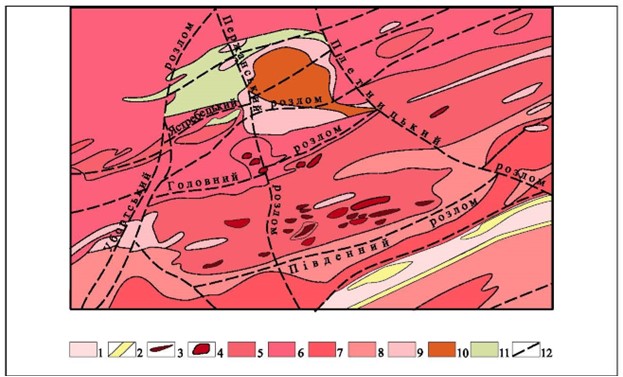
The massif is stratified, has an oval, lopolitoid-like shape, elongated in a north-westerly direction. The area of the massif is 4 square kilometers. The age of syenites, according to Isochron zircon is 1720 million years.
The massif crosses medium-coarse-grained Perga granites with the formation of an endocontact zone of hardening changes.

Genthelvite of the Perga Beryllium Deposit
The Perga beryllium deposit is so far the only deposit in the world where industrial concentrations of beryllium are associated with Gentgelvin. This mineral is the final member of the isomorphic series of minerals of the gelvin group — framework beryllium silicates. In total, about 50 finds of minerals of the helvin group are known in the world, which are of mineralogical interest only, while genthelvin (Zn4 (BeSi2)3S) is considered the rarest. In total, about 10 of his exotic finds were known, 7 of them in pegmatites. A new high-quality type of beryllium ores in alkaline (feldspar) metasomatites with gentgelvin was found for the first time in the world practice in the Precambrian in the marginal part of the Ukrainian shield within the boundaries of the Sushchano-Perga tectonometasomatic zone of activation.
Two areas have been explored at the deposit: Krushinka and Severnaya. The ore zones have a consistent occurrence with the extension of the main structural elements of the Sushchano-Perzhan zone, their length reaches 5 km with a width of up to 35-100 m. The ore zones are traced down to a depth of 400 m. from the first meters to 20-30 m. Ore bodies, composed of feldspar and mica-quartz-feldspar metasomatites, form lenticular and vein-like deposits of complex shape (characteristic swellings, blunt wedging) with rich Gentgelvin mineralization (average content of BeO 0.55%, the maximum is 8%). The ore bodies are bordered by a band of granites 5-30 m wide with blue newly formed quartz. In the upper parts, the ore bodies are mainly composed of albite microcline metasomatites, in the lower ones – mica-quartz-feldspar metasomatites. The phenakite mineralization, formed at the early stage of ineral formation, is spatially separated from the Gentgelvin mineralization, being localized primarily in the western endocontact of the Perga granite massif, where it forms poor (average BeO content 0.2%) interspersed mineralization. Associated accessory minerals – cassiterite, columbite, zircon.
A large number of rare elements – Nb, Ta, Sn, Zn, TR, Th, Li, Rb, Cs, Pb, Mo, F, etc. – accumulated in metasomatites (up to industrial concentrations). The main beryllium-concentrating minerals in ores are gentgelvin and phenakite. Gentgelvin contains 11.2–13.0% of BeO, and 90.8–97.2% of beryllium oxide reserves are associated with it. The share of phenakite containing 43.7-44.0% of BeO accounts for only 2.6-8.9% of the deposit reserves [6].

CONCLUSIONS
1. The main carrier of beryllium in the Perga deposit is the mineral – genthelvite (Zn4 (BeSi2)3S). The deposit is currently the only one in the world that is represented by this mineral.
2. Associated accessory minerals – cassiterite, columbite, zircon.
3. The Perga beryllium deposit is significant in terms of mineralization and the raw materials quality. The deposit has never been exploited, which gives a big advantage – to start from a `zero basis` with the untouched resource potential of beryllium raw materials. A favorable fact that is none of countries has such a geological-industrial type occurrence of beryllium deposits as Ukraine.
4. In addition to beryllium, in lower ore concentrations, the deposit contains tantalum, niobium, zirconium, lithium, zinc, molybdenum, gold, silver.
5. The deposit is not completely investigated. Even with the existing estimated reserves, it belongs to the category of large ones; it has significant prospects for the BeO reserves growth at a depth and in the central part. A reliable reserve for further development and increase ofenterprise’s operational potential is phenakite ores.
6. Generally, performed calculations show that the development of beryllium-containing ores is today economically attractive regardless of a possible reduction in world prices. Accompanying products – Al2O3, ZnO and SiO2 – may play a role in reducing project risks.
Note.
The materials of the report used the actual data of copyright research, geological funds of Ukraine, reports of the Zhytomyr Geological Expedition, open sources.
Useful links:
- https://www.usgs.gov/media/images/world-map-showing-beryllium-deposits
- https://d9-wret.s3.us-west-2.amazonaws.com/assets/palladium/production/s3fs-public/thumbnails/image/pp1802-Be-deposits.png
- https://perzhanskrud.com.ua/
- https://www.facebook.com/100001651887909/posts/5625888587476148/?d=n
- file:///C:/Users/User/Downloads/45.pdf
- http://dspace.nbuv.gov.ua/bitstream/handle/123456789/57321/09-Galetskiy2.pdf?sequence=1
APPENDIX
NOTICIA RELACIONADA

